The Vertiv Edge Lithium-Ion 1500 VA UPS Review: Impeccable Power, Imposing Price
by E. Fylladitakis on April 22, 2022 11:00 AM EST- Posted in
- Cases/Cooling/PSUs
- UPS
- 1500VA
- Vertiv
- Li-Ion
Testing
| UPS Load Performance | |||||
| 10% | 25% | 50% | 75% | 100% | |
| Voltage Output (Vrms) | 230 | 230 | 230 | 230 | 230 |
| Frequency (Hz) | 50.05 | 50 | 50.05 | 50 | 50 |
| Transfer Time (ms) | 3.6 | 4.3 | 4.5 | 4.8 | 5.2 |
The basic electrical figures for the Vertiv Edge Lithium-Ion 1500 VA are excellent, with the transfer time beating even the manufacturer’s own specifications. Vertiv specifies that the Edge Lithium-Ion has a typical transfer time between 4 and 6 ms but we recorded transfer times below 4 ms during load loads. The output is always rock-solid at 230 V RMS and 50 Hz, regardless of the load.
The fan outputs 42.3 dB(A) while it is running at maximum speed. Vertiv has programmed a load-based control of the fan’s speed into the Edge Lithium-Ion, meaning that the fan will reduce its speed according to the load while the unit is running on batteries. This initially seemed like a nice approach, but the fan will always run at maximum speed while the unit is recharging its batteries. Therefore, if the unit operates at just 25% load and there is a ten-minute outage, the fan will be nearly silent for ten minutes during the outage and then will be running at maximum speed for nearly two hours, practically negating the benefits of having a fan speed controller in the first place.
The battery runtime of the Vertiv Edge Lithium-Ion 1500 VA is better, but close, to what's advertised. These figures are achieved with its batteries fully charged and while they are new. Vertiv claims that the batteries can last up to ten times longer than typical valve regulated lead–acid (VRLA) batteries but that is not something we can verify within the timeframe of a review. The company does offer a five-year warranty on the batteries though, which is by far the best we have ever seen to this date. The recharging speed of the Lithium-Ion battery is also leagues ahead of any Lead-based battery, with the Edge Lithium-Ion 1500 VA UPS recharging its battery at least three times faster than an equivalent product with a sealed Lead-acid battery.
The output of the Vertiv Edge Lithium-Ion 1500 VA impresses as well, delivering a nearly perfect sinewave. Of course, it is not a true sinewave – a true sinewave is not physically possible without an ideal rotating machine – but it is a very close approximation of it. If we take a very close look at the waveform, we will see a very fine stepped wave.
What is very impressive about it is that the output is virtually unaffected by the load – there is only a tiny waveform deformation between zero and maximum load, barely discernable on the oscilloscope and practically negligible.
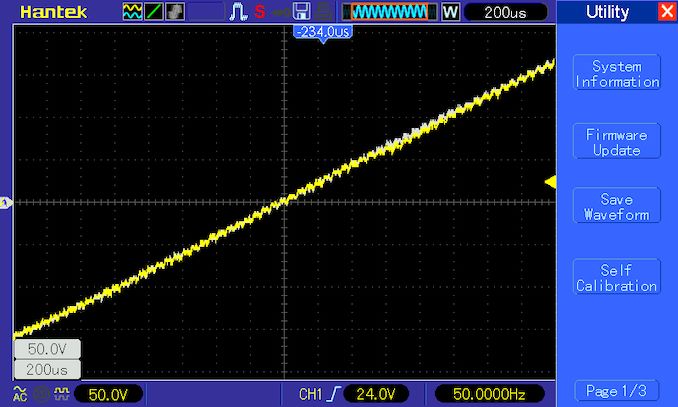
Blue line: Zero load / Yellow line: 1350 Watt load
The Vertiv Edge Lithium-Ion 1500 VA UPS also is exceptionally stable when the load suddenly shifts. The capture below reveals the worst output waveform deformation that we managed to cause while the unit was running on batteries and we had to immediately switch the load from zero to 100% in order to realize it - a completely unlikely real-world scenario.
Conclusion
Vertiv typically designs products for IT infrastructure and industrial sites. With the Edge Lithium-Ion 1500 VA UPS, Vertiv is trying to make a move towards the high-end retail market with a product that was initially designed for critical IT infrastructure, particularly for sites where frequent maintenance may difficult. Due to its intended design, we expected that its electrical performance would outclass more retail-grade products, and the Edge Lithium-Ion 1500 VA UPS did not let us down.
As far as consumer/household use is concerned, the UPS also fares very well there since it's dead-quiet while fully charged and running on AC power. The flip side to that, however, is that the fan can be loud when the UPS needs to charge its batteries. Although Vertiv’s engineers tried to implement a fan speed controller, the application was not brilliant, as the fan still operates at maximum speed most of the time. The saving grace here is the short battery charging time, meaning that the fan will not stay at maximum speed for several hours, as is the case with the vast majority of retail lead-acid UPS designs.
The highlight of this particular UPS obviously is the lithium-Ion battery. A VRLA battery of equal capacity would be almost twice as large and heavy, and as you might expect, Vertiv seems to be bringing that up a lot in their marketing brochures. But these are admittedly not significant advantages for stationary installations.
Rather, the two truly important advantages of using a lithium-Ion battery are its lifetime and charging current. The lithium-Ion battery will live for much longer than a typical VRLA battery and may even outlive the service life of the UPS itself, which is why Vertiv is so comfortable with offering a five-year warranty on the battery. It can also be charged much faster than VRLA batteries, with the Edge Lithium-Ion 1500 VA charging its battery from 10% to full in a little over two hours. This is very important in areas where the electricity supply is unreliable and the UPS needs to keep critical infrastructure, like a security system, communications equipment, or even a medical system, always running. If the load of the UPS is low, the Edge Lithium-Ion 1500 VA can keep equipment running even if the electrical grid is available for less than half of the day.
For the retail consumer, the advantages of owning a UPS like the Vertiv Edge Lithium-Ion 1500 VA are obvious. As the UPS was initially designed to protect critical infrastructure, it goes without saying that its electrical performance is outstanding, with exceptional transfer times and amazing output power quality. The lithium-Ion battery also offers rapid charging-discharging times and has a significantly greater lifetime than typical VRLA batteries. Undoubtedly, the Vertiv Edge Lithium-Ion 1500 VA is an excellent UPS by current standards, with fantastic overall performance and a lengthy warranty.
However, Vertiv is not a company with a strong retail presence, and as a result they seem to have difficulties truly bringing their products down to the high-end consumer market and making them available from more consumer-focused retailers. As such, not only is the retail price of the Edge Lithium-Ion 1500 VA unit well above $1.000 at the time of this review, but its retail availability is also limited, impairing the market potential of the unit. So while it's a fantastic UPS overall, given the high price tag, the only users we can really envision buying an Edge Lithium-Ion unit to begin with are those who need to protect very expensive equipment and/or have to deal with a very low-quality electrical grid. And, for better or worse, there are a number of other top-performance UPSes that are readily available from retailers even when the Edge is not.


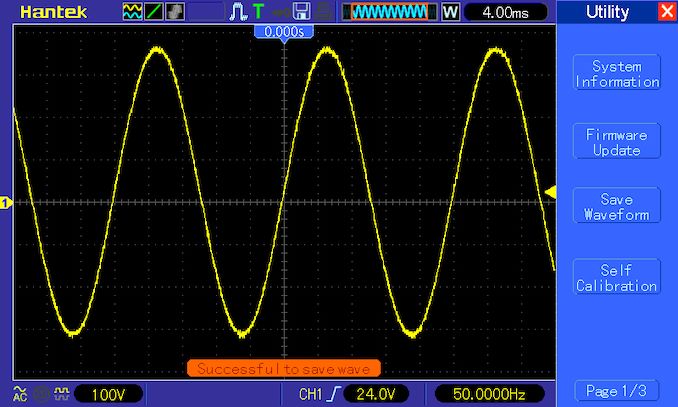

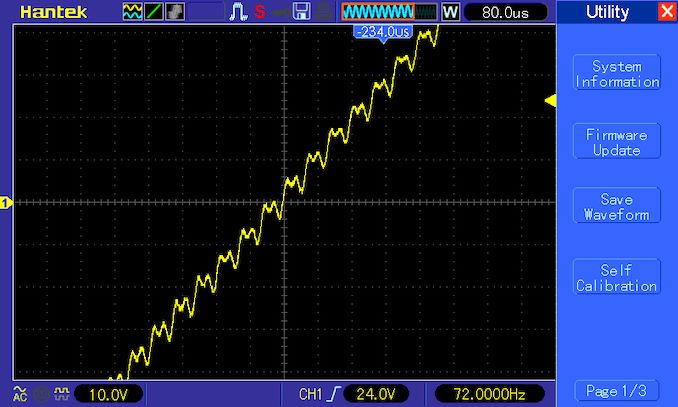
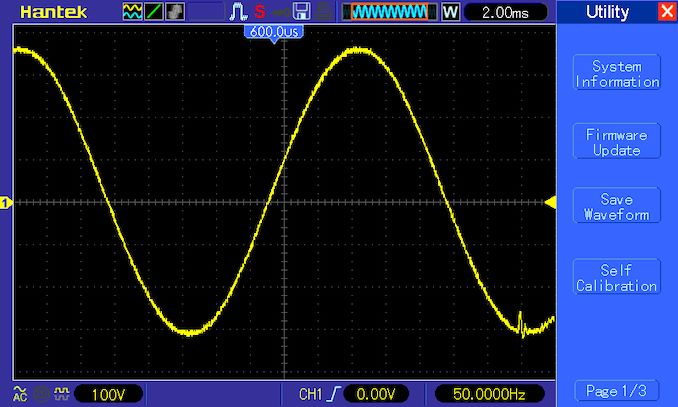
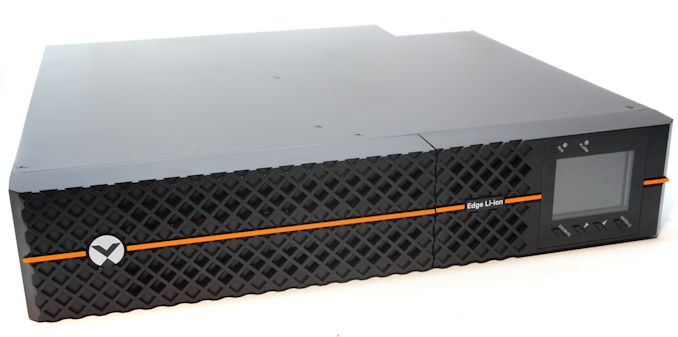
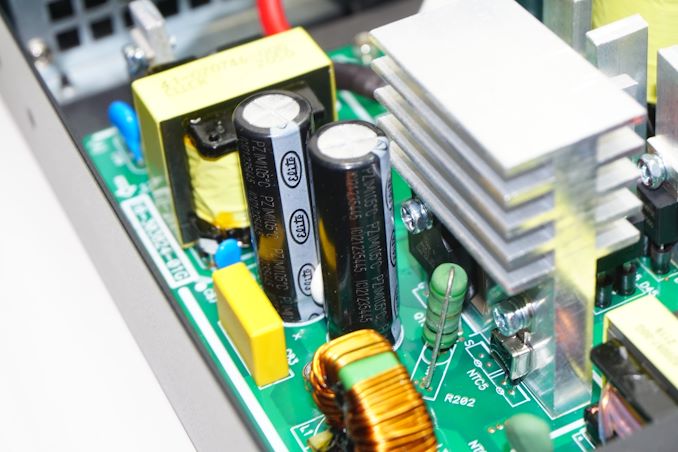
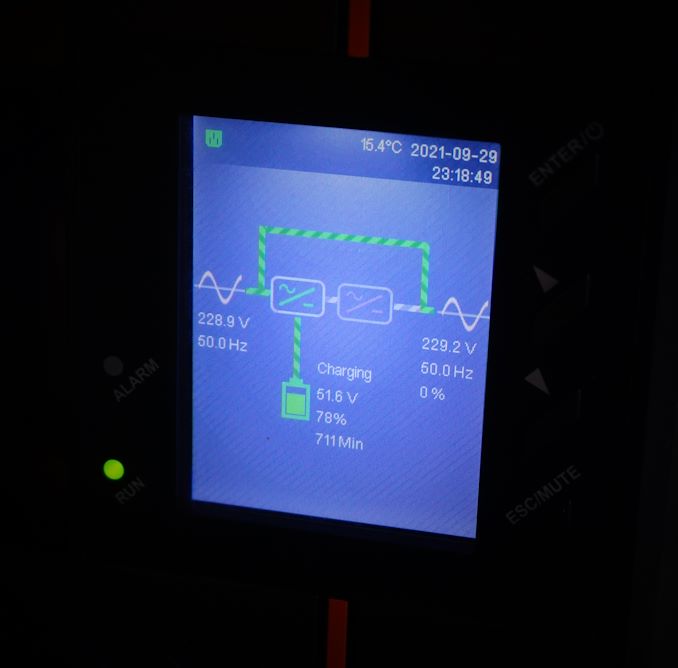








44 Comments
View All Comments
JFish222 - Sunday, April 24, 2022 - link
Hi @RyanSmith and @E. FylladitakisI love the new coverage!
I was one of the last posts (page 10) on the last review, and am reposting here for visibility . . .
Another +1 for these types of reviews, and additional suggestions:
1. What is the UPS power draw from the wall when not charging/under load (as mentioned by others).
2. What status monitoring / remote shutdown capabilities are present.
In addition to running the local "Powerchute Personal Edition" type software connected via USB, are there remote shut down agents when connecting multiple devices? Are there fleet management capabilities if I have one under every desk, etc.
3. Low voltage protection (also alluded to, was another interesting question). IE: In the event of an outage, does the battery run to 0% (not grate for Lead Acid), or is there an x% cut-off to protect the battery
4. Parasitic draw when the unit is powered off.
Can I keep the unit offline (ie: not in production) but with batteries internally connected without damaging the batteries? There is a natural discharge rate for lead-acid, but if there is parasitic draw even when off, those batteries could be toast when I pull the unit from the cabinet.
5. [When Applicable] Do the USB ports function when the UPS (inverter) is powered down.
It's an edge case, but not always well identified in specs. In the event of a hurricane/wildfire/[insert longer-term-outage] occurs, this can be a lifesaver. This also may have some IoT applications.
To those wondering about adding more sockets . . .
For those wondering what to do if you lack enough power ports on the UPS, I install passive mini extension cords.
The "squid" style ( https://www.amazon.com/dp/B075ZRB14L) and 12" mini-extension (https://www.amazon.com/dp/B09TC7ZPCJ/) are my go-to's. To address potential criticism of this approach, I always use grounded, passive cords and keep the loads in line with the UPS specs. We work with what we've got!
E.Fyll - Monday, April 25, 2022 - link
Thanks for your feedback J. I will be adding most, if not all, of these tests in future reviews.mikegrok - Sunday, April 24, 2022 - link
You keep referring to a lithium ion battery, which this is not. It is a lithium iron phosphate battery. Lithium iron phosphate batteries get damaged if they discharge faster than 1C, though they can do 3C for 30 seconds. This battery is nearly 250 watt hours. To reach 1500watt, it would need to be discharged at 6C.I will be building a generator backed ups at my house soon. Using one or more growatt 5kw inverter chargers, and a 14kwh battery pack made out of 16 280ah lifepo4 cells. In the last 4 years we have had 2 power outages that lasted more than a week.
mikegrok - Sunday, April 24, 2022 - link
The growatt inverter chargers are around $0.20 a watt from US resellers. The battery cells are $100 each on alibaba. I will also need a $300 Daly bms (300 Amp) for the string. As this battery pack can supply up to 14kw continuous.If I use the battery pack at it’s maximum output with 3 growatt inverters in parallel (they can do 6 in parallel), battery cells, bms, etc, it should be around $5k, or $350/kw for an hour. Or $500/kw for a 2 hour battery.
Jp7188 - Sunday, May 8, 2022 - link
Thanks for sharing. I always learn a lot from reading the comments.E.Fyll - Monday, April 25, 2022 - link
Lithium Iron Phoshate (LiFePO4) batteries also are Li-Ion batteries.LiFePO4 is a specific chemistry, one of many that are used to create Li-Ion batteries. LiCoO2, LiFePO4, NMC, etc., all are Li-Ion batteries.
Furthermore, LiFePO4 batteries have one of the greatest discharge rates, much higher than all Lead-based batteries that are commonly used in UPS systems. Certain implementations can reach 80C discharge, which is why they are used in high-performance electric vehicles, where rapid charging/discharging is the norm. It does affect the battery's lifetime but a high discharge rate will not damage the battery as quickly as you probably imagine.
t.s - Wednesday, April 27, 2022 - link
I think the more accurate is: Lithium battery. Can be read at: https://dragonflyenergy.com/types-of-lithium-batte...pjcamp - Tuesday, April 26, 2022 - link
Unless I missed it, it seems weird to review UPSs and not say whether they are switching or double conversion. At $1200, if this one is switching, that would be a criminal act. I've tried a ton of switching devices over the years and none of them work. Due to a large number of trees, my neighborhood experiences a lot of one second down and up power outages. Every single one of them has crashed every single device connected to a switching UPS.Tunnah - Wednesday, April 27, 2022 - link
If you're like me and don't understand all this sine wave stuff or just want to know what it means better, I found this extremely helpful:https://nerdtechy.com/ups-need-pure-sine-wave
macwhiz - Thursday, April 28, 2022 - link
The comments about the variable-speed fan seem off base to me. Running the fan at a lower speed when running on battery power would reduce the draw on the battery and therefore increase run time, would it not? In a rackmount device, sound levels are virtually never a consideration. It's unlikely the recharging UPS would be audible over all of the 40mm fans in the 1U rack servers and switches...